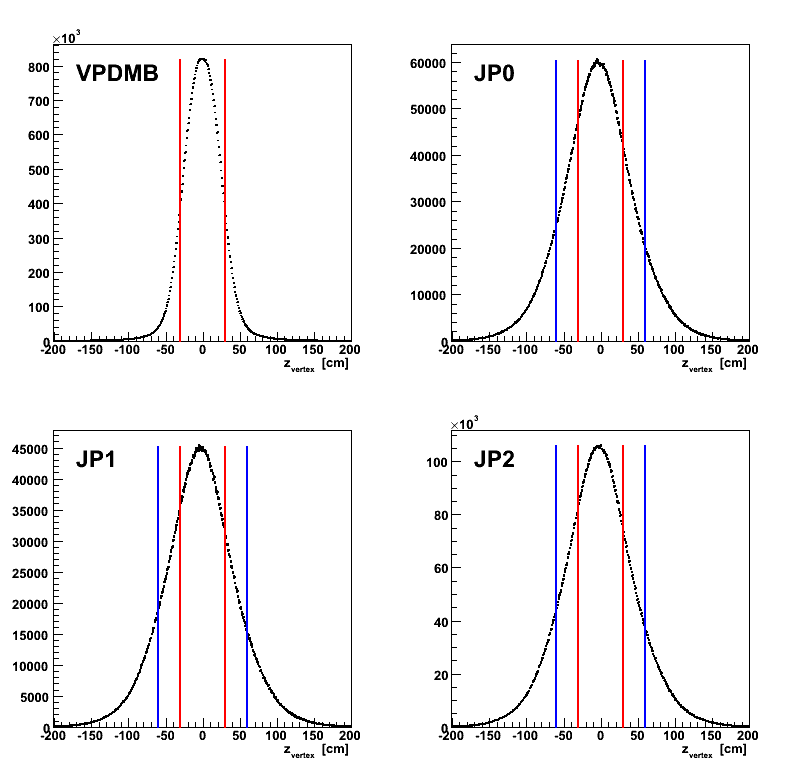- drach09's home page
- Posts
- 2022
- 2020
- June (1)
- 2019
- 2018
- 2017
- 2016
- 2015
- 2014
- December (13)
- November (2)
- October (5)
- September (2)
- August (8)
- July (9)
- June (7)
- May (5)
- April (4)
- March (4)
- February (1)
- January (2)
- 2013
- December (2)
- November (8)
- October (5)
- September (12)
- August (5)
- July (2)
- June (3)
- May (4)
- April (8)
- March (10)
- February (9)
- January (11)
- 2012
- 2011
- October (1)
- My blog
- Post new blog entry
- All blogs
Run-11 Transverse Jets: Revisiting Cuts
As we move toward a final result, I estimate the following as the list of necessary tasks:
- Repeat analysis with R = 0.5 and decide upon the optimal radius cut
- Revisit analysis cuts
- Revisit systematic uncertainties
- Determine if more embedding is warranted
By rights, I should do the first bullet with my newer jet trees including the VPD information. Toward the second bullet, I list, below, the current analysis cuts.
- Event Cuts
- VDPMB or JP0 or JP1 or JP2 or AJP trigger in hardware and software (JP-triggers only)
- Vertex Rank > 0
- |zvtx| < 30 cm
- Good spin bit
- Jet Cuts
- No jets with hadron pT > 30 GeV/c
- RT < 0.98
- ∑Track pT > 0.5 GeV/c
- |ηdet, jet - 0.1| < 0.8
- |ηjet| < 1.0
- "Could fire" JP-trigger patch with associated pT condition or VDPMB trigger with pT > 6 GeV/c
- "Could fire" means |ηjet-ηpatch| < 0.6 and |φjet-φpatch| < 0.6
- Hadron Cuts
- ΔR > 0.1
- -1.0 < nσ(π) < 2.5
- Nhits dE/dx > 5
The following cuts are probably worth revisiting, prior to publication: zvtx, RT, nσ(π), and ΔR.
Revisiting the Neutral-energy Fraction Cut
Pibero and Zilong have found that to exclude single-beam backgrounds, a more stringent requirement of RT < 0.94 is safer than my current upper-limit of 0.98. Thus, I will switch to RT < 0.94 for the final result. This change is practically of no substance for the Collins(-like) analyses. There, I require a charged pion with z = 0.1, meaning charged particles must carry at least 10% of the jet momentum and RT ≲ 0.9.
Revisiting the PID Cut
For the preliminary result, I used -1.0 < nσ(π) < 2.5. This was slightly looser than Rob's 2006 cut of -1 < nσ(π) < 2, however, I may yet be able to loosen the cut further.
Figure 1

In Fig. 1 I show the PID distributions for VPDMB in data and embedding. In orange I show the existing cut and in lighter blue I show a possible new lower bound. By loosening to -1.5, the fits indicate I would increase my VPDMB pion yield by ~60k with the contamination increasing by ~0.2%.
One other matter concerning PID is that the pion contamination indicated by the nσ(π) is significantly lower than what I derive from the simuatlion by matching to a true charged pion. For the preliminary result, I used the simulation rather than the data PID to estimate a systematic. Note: I did not correct for this but simply applied a systematic, since was not immediately clear why this was so. If I can understand this discrepancy it is possible I may be able to reduce this systematic for the paper.
Revisiting the Event Vertex Cut
The 30 cm cut was set based upon the VDPMB events that exhibit a much narrower vertex distribution than the jet-patch triggers. Thus, it may make sense to expand the window for the jet-patch triggers.
Figure 2

In Fig. 2 I show the zvertex distribution for VPDMB, JP0, JP1, and JP2. One can clearly see that the VPDMB distribution is much narrower than the jet-patch distributions. Thus, a 30 cm vertex cut (shown in red) seems not so crazy for minbias. However, the 30 cm cut is a bit extreme for the jet-patch triggers. Thus, I propose a 60 cm cut (shown in blue) for the jet-patch triggers. This will provide a nice increase (~60%) in statistics for the jet-patch triggers. Zilong and Pibero have used windows of ±90 cm. If the dE/dx distributions do not indicate enhanced pion contamination with the wider window I may be able to increase my statistics even more with the ±90 cm window.
- drach09's blog
- Login or register to post comments
